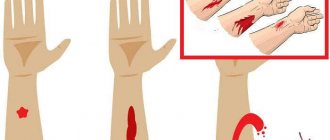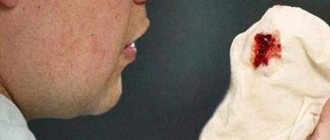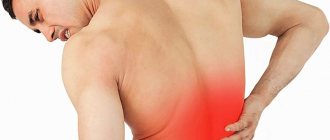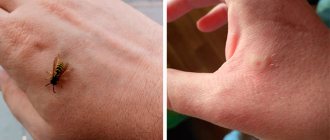© Author: Inna Makarenko, general practitioner (USA, Massachusetts, Boston), especially for SosudInfo.ru (about the authors)
The body of humans and mammals is permeated with thousands of small, medium and large vessels that contain a valuable liquid that performs a huge number of functions - blood. Throughout life, a person experiences the influence of a considerable number of harmful factors, among them the most common are traumatic effects such as mechanical damage to tissue. As a result, bleeding occurs.
What it is? The medical science of “pathological physiology” gives the following definition to this condition: “this is the release of blood from a damaged vessel.” At the same time, it pours out or into the body cavity (abdominal, thoracic or pelvic) or organ. If it remains in the tissue, saturating it, it is called hemorrhage; if it freely accumulates in it, it is called a hematoma. A condition in which blood vessels are damaged, most often occurring suddenly, and if there is a strong rapid leakage of vital fluid, a person can die. That is why first aid for bleeding often saves his life, and it would be nice for everyone to know the basics. After all, such situations do not always occur when there are medical workers nearby or even just specially trained people.
Kinds
Bleeding, the concept and types of which depend on certain signs, can be divided into types.
Classification of bleeding:
| Sign by which bleeding is classified | Types (types) of bleeding | Brief description of the process, characteristic features |
| Place where blood is poured out | Hidden | Hidden bleeding is characterized by hemorrhage into parts of the body that are not connected to the environment. Most often, this process occurs in the cavity of the duodenum or stomach. Bleeding can only be determined using laboratory diagnostic methods. |
| Internal | Internal bleeding is characterized by hemorrhage not into the environment (as with an external process), but into the cavity of another organ or the gaps between tissues. Hemorrhage can occur in the brain, uterus, and stomach. Internal bleeding is very dangerous, since it is impossible to immediately identify the affected organ and carry out medical procedures. | |
| External | External bleeding can be easily determined by visual examination of the patient. Also, in some cases, bleeding can be easily stopped. The outpouring occurs into the external environment. | |
| Severity of bleeding | Lung | Light bleeding is characterized by a loss of 10-15% of the total circulating blood volume. Blood loss with such hemorrhage is no more than 0.5 liters. |
| Average | This type of hemorrhage is characterized by a loss of 0.5 to 1 liter of biological fluid. This blood volume is about 16-20% of the bcc. | |
| Heavy | Loss of more than 1 liter (no more than 1.5 liters) of blood. Also, a severe form of hemorrhage is characterized by a loss of more than 20% of the volume of circulating biological fluid. | |
| Massive | Massive bleeding is characterized by a loss of 30-40% of the volume of blood volume. | |
| Lethal | A feature of a fatal hemorrhage is the loss of about 2000-2500 ml of biological fluid. | |
| Absolutely lethal | More than 3 liters or a loss of 60% (or more) of the total volume of circulating blood characterizes absolute fatal bleeding. | |
| Type of damaged vessel | Venous | Venous bleeding is characterized by continuous flow of biological fluid from the wound (slight pulsation is possible). The process can be fatal, depending on how large the veins are affected. Venous blood is darker and more saturated in color. |
| Arterial | The most dangerous type of hemorrhage is arterial. In a short period of time, you can lose a large volume of blood, which can lead to death. The blood coming out during damage to the arteries is scarlet in color. Another distinctive feature is the mechanism for releasing blood - the biological fluid flows like a fountain. Despite the danger of this phenomenon, hemorrhage can be stopped. There are several ways to stop bleeding from such an injury. | |
| Capillary | The main feature of capillary bleeding is the ability to quickly and easily stop the bleeding yourself. With capillary bleeding, it is difficult to distinguish the bleeding vessels with the naked eye, since they are very small. The shade of capillary fluid is a mixture of arterial and venous bleeding. Hemorrhage can only be dangerous for people with bleeding disorders. | |
| Parenchymatous | It is almost impossible to stop such bleeding on your own. Parenchymal hemorrhage is associated with disruption of the parenchymal organs or severe damage to the thoracic or abdominal cavities. Biological fluid flows over the entire surface of the wound. Blood appears in two shades - arterial and venous. | |
| Mixed | Mixed hemorrhage is characterized by damage to both arteries and veins, and capillaries. You can take the first measures to help the victim yourself. The measures taken to stop the bleeding depend on the most dangerous types of bleeding. | |
| Bleeding time | Primary | In primary bleeding, the process occurs immediately after damage to the vascular system. |
| Secondary (or early secondary) | Secondary hemorrhage is characterized by the appearance of biological fluid no more than 3 days after injury. Bleeding occurs as a result of blood clot rejection caused by increased blood pressure. | |
| Late secondary | Late secondary bleeding may appear several days or weeks after injury. | |
| Origin of the process | Traumatic | Traumatic bleeding is the release of biological fluid as a result of mechanical damage to blood vessels. |
| Pathological | Pathological bleeding is characterized by damage to blood vessels as a result of pathological processes of the cardiovascular system. |
Types of external bleeding.
The color of the blood and the nature of the flow will help you understand which. Also, experienced specialists can distinguish several types of bleeding depending on the first aid technique. Bleeding, the concept and types of which depend on the location of the hemorrhage, into the internal environment is the most dangerous for the body.
There is a separate classification for internal bleeding:
- Gastrointestinal bleeding. One of the most common forms of internal bleeding. This spread is explained by numerous gastrointestinal diseases. Most often, bleeding can occur with acute ulcers and gastric erosion. The most common manifestation of bleeding in the cavity of the gastrointestinal tract is vomiting blood.
- Pulmonary hemorrhages are characterized by expectoration of blood. It is also possible to produce copious amounts of body fluid when coughing. Hemorrhage can be a consequence of tuberculosis, bronchial tumors.
- Bleeding into the abdominal and pleural cavity. This phenomenon can be the result of a closed injury, during which parenchymal organs are damaged. Such bleeding can be a consequence of a minor injury, which can only be determined by the appearance of anemia.
- Intrapleural bleeding. Determine this subtype of hemorrhage by human breathing. The chest may rise unevenly. Noises also appear during gas exchange.
There is also a separate subtype - intra-abdominal bleeding. It is determined by finger examination.
Description
Abnormal uterine bleeding (AUB) is a change in menstrual function caused by a violation of the cyclic production of ovarian hormones.
Functional changes leading to uterine bleeding can occur at different levels of regulation of the menstrual cycle: in the cerebral cortex, hypothalamus, pituitary gland, ovaries, thyroid gland, adrenal glands.
There are the following types of menstrual irregularities:
- polymenorrhea - characterized by short breaks between cycles, which leads to frequent menstruation;
- metrorrhagia – intermenstrual bleeding;
- menorrhagia – characterized by severe blood loss during menstruation, the duration of which exceeds the physiological norm. It is important to note that menstruation in this case appears at regular intervals;
- menometrorrhagia – irregular, prolonged uterine bleeding.
The following forms of abnormal uterine bleeding (AUB) are distinguished:
- AUB of the juvenile period (from 12 to 17 years);
- AUB of the reproductive period (from 18 to 45 years);
- AUB of the premenopausal period (from 46 to 55 years).
In addition, abnormal uterine bleeding is divided into ovulatory and anovulatory. With ovulatory uterine bleeding, ovulation is present, but existing hormonal disorders lead to shortening/lengthening of the first or second phase of the menstrual cycle, which is the cause of bleeding. With anovulatory uterine bleeding, ovulation does not occur, resulting in an increase in the level of female sex hormones - estrogens. As a result, the endometrium increases in volume, which subsequently exfoliates, which causes abnormal uterine bleeding.
The following causes of AUB are identified:
- ovarian diseases (resistant ovarian syndrome, polycystic ovary syndrome, ovulatory syndrome, luteal phase deficiency, hormone-producing ovarian tumors, ovarian cysts);
- diseases of the uterus (endometriosis, adenomyosis, endometrial hyperplasia, uterine fibroids, endometrial polyps);
- diseases of the pituitary gland (acromegaly, pituitary hypogonadism);
- diseases of the adrenal glands (congenital adrenal hyperplasia, Cushing's syndrome);
- diseases of the thyroid gland (hyperthyroidism, hypothyroidism);
- diseases of the blood coagulation system (hemophilia, idiopathic thrombocytopenic purpura, Osler-Rendu-Weber disease)
- chronic diseases of other organs (liver cirrhosis, pyelonephritis and others);
- taking certain medications (for example, hormonal drugs, antipsychotics)
- excess or deficiency of body weight.
According to statistics, abnormal uterine bleeding often recurs and leads to reproductive dysfunction. In turn, hormonal disorders that occur with AUB can lead to the development of hyperplastic processes, including precancer and endometrial cancer. If you consult a specialist in a timely manner and follow all the doctor’s recommendations, the prognosis is usually favorable.
Symptoms
Symptoms of bleeding, like the concept of the term, are associated with the types and types of hemorrhage. There are local and general symptoms of this phenomenon.
Common symptoms of hemorrhage include:
- fatigue and drowsiness;
- weakness;
- thirst;
- lightening of the skin due to decreased vascular tone (the lips turn pale most noticeably);
- anemia;
- dizziness, frequent fainting is possible.
Also among the main symptoms can be identified the direct process of the circle leaving the vascular bed.
Local symptoms of bleeding include:
- with pleural bleeding , in addition to general symptoms, shortness of breath appears. Also, breathing becomes confused, the sound when inhaling and exhaling is shortened. Possible weakening of gas exchange;
- the main symptom of bleeding into the cranial area is symptoms of acute or chronic compression of brain tissue;
- Bleeding into a joint is a simple and non-fatal process. The joints are small in volume, so acute anemia does not occur. When joint bleeding occurs, general symptoms of hemorrhage appear.
- hemorrhages into the abdominal cavity are unpleasant and painful processes. The symptoms of this subtype are associated with irritated organs of the gastrointestinal tract - nausea and vomiting. You may also notice muscle tension in the injured area.
- interstitial hematoma. The strength of the symptoms of a hematoma depends on the location and size of the hematoma. Symptoms include swelling in the damaged area, hardening of the tissue, and severe pain. It is also possible that the volume of damaged tissue may increase.
Hematomas can become the cause and starting point for the development of gangrene.
Medicines
Photo: womensmed.ru
The most commonly used hemostatic (hemostatic) agent is aminocaproic acid, which inhibits fibrinolysis, thereby achieving the necessary therapeutic effect. The effect of the drug when administered intravenously appears after 15–20 minutes. The use of aminocaproic acid may be accompanied by the following side effects:
- headache, general weakness;
- arterial hypotension, decreased heart rate (heart rate);
- periodic aching abdominal pain, nausea, vomiting, diarrhea;
- in some cases, confusion and the appearance of hallucinatory images are noted.
If necessary, oxytocin, which is a uterotonic agent, is used. The drug causes contraction of the uterine muscles, which is achieved due to its effect on the membranes of myometrial cells.
In the future, as a rule, hormonal drugs are prescribed. The choice of a specific remedy is made by a doctor, who relies on a particular clinical case and the individual characteristics of the patient’s body. Goals of hormone therapy:
- normalization of the menstrual cycle;
- prevention of recurrent uterine bleeding;
- rehabilitation of impaired reproductive function, restoration of fertility in the presence of infertility.
With the development of posthemorrhagic anemia, in order to correct this condition, iron preparations (maltofer, ferrum lek, ferronal, ferretab comp) are prescribed, which compensate for the lack of the substance and increase hemoglobin. Available in forms for oral administration and parenteral administration. The following side effects may occur while taking iron supplements: occasional abdominal discomfort, dyspepsia, constipation or diarrhea. It is also worth noting that taking iron supplements in some cases leads to a change in the color of feces, which is associated with the excretion of unabsorbed iron.
To generally strengthen a woman’s body, vitamin and mineral complexes are prescribed, which contain all the necessary microelements.
Reasons for appearance
Bleeding, the concept and types, as well as the causes of which depend on the factors affecting the body, is the release of biological fluid (blood) through the vascular bed into the environment or into the body cavity.
The causes of hemorrhage include:
| Type of bleeding | Reason for appearance |
| External | External bleeding occurs as a result of a violation of the integrity of the skin, veins or arteries. Depending on the affected vessels, there are also several types of bleeding. Blood may leak onto the surface of the body from wounds, ulcers and skin tumors. |
| Interstitial | The cause of interstitial bleeding is bruises or fractures, various types of injuries. Also an important factor in the development of interstitial hemorrhage can be pathologies of the cardiovascular system associated with vascular permeability and blood clotting. |
| Intracavity | Intracavitary bleeding is closely related to injury to a parenchymal organ. The disease can also develop due to the pathology of a damaged organ. |
| Pulmonary | Pulmonary hemorrhage is the most dangerous, since during the hemorrhage the biological fluid can completely fill the lung. When the lungs are damaged, there is a lack of air and breathing problems. Pulmonary hemorrhage can result from advanced forms of respiratory system diseases. Congenital defects and pathologies also influence the appearance of hemorrhage. |
| Gastrointestinal | The causes of gastrointestinal hemorrhage are ulcers, colitis, and tumors. Also, vomiting blood can be caused by foods that are contraindicated for a certain disease. |
| Afibrinogenic | The cause of this hemorrhage is severe and lengthy operations on the abdominal and thoracic cavity. Over a long period of time, a lot of fibrinogen is consumed. |
| Postoperative | Postoperative hemorrhages = secondary. They occur when a blood clot is pushed out. |
There is also a classification of bleeding according to the affected vessel. The cause of such hemorrhages is direct trauma to the blood vessels or diseases of the vascular system.
How to help a patient with severe bleeding from a vein?
The rules for providing assistance will depend on the size of the damage.
In case of injury to the superficial vein, the action algorithm will be as follows:
- The wound area is washed with a solution of hydrogen peroxide.
- A tight bandage is applied to the wound. You can place a sterile napkin or a piece of soft cotton cloth, previously ironed with a hot iron, on the surface of the wound. A tight ball of cotton wool is placed on a napkin. Then the wound is tightly wrapped with a bandage, movements must be made in a circle.
- The patient is taken to the doctor for examination and professional assistance.
If the bandage becomes saturated with blood for a short time, it should be assumed that damage to the deep veins has occurred.
If deep veins are damaged, you should:
- Perform all actions promptly, since significant blood loss can lead to irreparable consequences.
- It is recommended to immediately raise the injured limb.
- Then a medical tourniquet must be applied. It must be placed slightly below the wound area.
- You can apply ice or a heating pad with cold water to the affected area.
If the veins in the neck are damaged, applying a tourniquet is impossible. To provide first aid, perform the following steps:
- The vessel is pinched with fingers above and below the site of injury.
- The access of air to the bloodstream is blocked with a napkin soaked in hydrogen peroxide. It seals the wound.
- Cold is applied to the bleeding site.
- The victim needs to be taken to the hospital, where he will undergo emergency surgery.
Diagnostics
Diagnosing external bleeding is quite simple - it only requires a visual examination of the victim. Based on the nature of the wound and blood, you can easily determine the type of hemorrhage and provide assistance.
Internal bleeding can be diagnosed in the following ways:
- Endoscopy. Allows you to determine pulmonary and gastrointestinal hemorrhages. During the procedure, a tube is inserted into the patient's cavity. An endoscope is used to examine the area being diagnosed. The comfort of this process depends on the specialist. Endoscopy is a fairly inexpensive procedure. You can find clinics that provide services at a cost of 350 rubles.
- Ultrasonography. Ultrasound is the most popular and safe way to diagnose the disease. Using a special device, the presence of pathology in the painful cavity is determined. The price of an ultrasound depends on the area being diagnosed.
- Magnetic resonance imaging. The procedure is carried out in a separate room using a tomograph. The cost of tomography varies from 1,500 to 8,000 rubles.
- Determination of the number of red blood cells. To determine the number of red blood cells, you need to donate blood for analysis. The price of this analysis is from 200 rubles and above.
You can also diagnose bleeding, and most importantly, its localization, based on pronounced symptoms. Among such manifestations are vomiting “coffee grounds”, blood in the stool, and hemoptysis.
When to see a doctor
Bleeding, the concept and types of which depend on the signs of the phenomenon, can be dangerous and even fatal for the body.
In what cases should you consult a doctor:
- with periodic changes in blood pressure (sudden jumps);
- hemoptysis due to illness or injury;
- vomiting “coffee” grounds;
- an ordinary hematoma does not subside for a long time, or it is very painful;
- If, with external bleeding, the wound is deep and touches an artery or vein, you should immediately seek help. In addition to blood loss, infection can occur.
- pallor of the skin due to anemia.
- swelling in the abdominal area;
- there is blood in the stool.
It is important to monitor your health, as with internal bleeding there is a high risk of death from blood loss.
Bleeding internal and external
This is the loss of blood from the circulatory system. Causes can range from minor cuts and abrasions to deep cuts and amputations.
bleeding
Injuries to the body can also lead to internal bleeding, which can range from minor (visible as superficial bruising) to massive bleeding.
First aid for severe external or internal bleeding is critical to limit blood loss until emergency medical help arrives. First aid measures to control external bleeding include applying direct pressure to the wound, maintaining pressure with pads and dressings, and, if possible, elevating the injured limb above the level of the heart.
How to stop treatment
Heavy bleeding cannot be treated at home. In case of profuse hemorrhage or hemorrhage into the natural cavities of the body, you must immediately call an ambulance, until which you only need to maintain the patient’s condition.
First aid
Providing first aid for external bleeding is quite simple. It is only important to follow all the “steps” and use sterile products to treat the wound.
In case of capillary bleeding, you only need to rinse and treat the wound with skin disinfectants. If the abrasion is small, then a plaster or wound glue is enough. A large wound surface can be bandaged.
In case of arterial bleeding, a tourniquet must be applied. The tourniquet should be applied above the wound to prevent blood flow to the cut site. If there is no special harness, then you can use a belt or other improvised elements. It is also necessary to take into account the time of application of the tourniquet and convey information to medical professionals.
In case of venous bleeding, a pressure bandage must be used. A pressure bandage creates a constant pressure on the vessel, preventing blood from leaking out. To create a pressure bandage you will need gauze/bandage/gauze pads and a gauze bandage. From gauze you need to twist a tight roller, which must be applied to the damaged area. It is necessary to secure the roller tightly on the limb with a bandage.
Assistance for internal bleeding must be provided very carefully so as not to worsen the victim’s situation. At the first signs, it is necessary to immediately take the patient to a medical facility.
First aid algorithm:
- Provide peace to the victim.
- If there are signs of pulmonary hemorrhage, it is necessary to give the floor a sitting position. In other cases it is necessary to lay it on a flat surface.
- Cold should be applied to the painful area.
It is forbidden to apply heat to the painful area, give laxatives and heart medications.
Medications
For external bleeding, you can use any disinfectants and aseptic agents to treat the wound site.
For internal bleeding, medications can be administered to stop the bleeding:
- Aminocaproic acid. It is administered intravenously. The volume of the drug should be calculated based on the age of the patient. The maximum dose of the drug is 18 g per m2. It is eliminated from the body quickly.
- Vikasol. The drug is produced in tablets and ampoules. It is also necessary to administer the solution depending on the age of the victim.
Vikasol
If it is not far from a medical facility, and the patient’s condition is not critical, it is best to refuse to use medications to avoid side effects.
Traditional methods
It is impossible to use traditional medicine as the only and main method of treatment - this can lead to complications and death. Traditional methods can relieve symptoms and become an auxiliary method of treating hemorrhage.
Using traditional methods, you can stop uterine bleeding. To do this, you need to boil the zest of 7 oranges in 1.5 liters of water, so that the result is 0.5 liters of pure broth. You need to consume this decoction 20 ml 3 times a day.
To stop pulmonary, gastric and intestinal bleeding, it is recommended to use herbal infusions. The most effective plants are “cat’s paw” and “medicinal letter”. The infusions should be consumed every hour until the hemorrhage stops.
Other methods
In addition to the classical methods of stopping blood, other methods can be used.
The use of such methods is relevant in field, stressful situations:
- Wound tamponade. Used for gunshot or knife wounds. To do this, you need to place the dressing material on the tip of the palm and insert it into the hole. Thus, it is necessary to fill the wound with a dressing material, changing hands without removing the finger from the hole. The tamponade must be secured with a bandage.
- Finger pressure on a bleeding vessel. Used when it is impossible to apply a tourniquet or pressure bandage. You need to press firmly and firmly on the wound to stop the bleeding.
- Flexion of the limb at the joint ensures difficult blood flow to the damaged vessel. It works in cases where the wound area is at the end of the limb. The limb must be fixed in a bent position. You can also simply fix the limb in an elevated state.
To correctly apply the method of stopping bleeding, it is necessary to correctly determine the location of the wound and the type of hemorrhage.
Heavy external bleeding
severe external bleeding
Even a minor injury can lead to severe external bleeding, depending on where it is on the body. This may result in shock. In medical terms, shock means that the victim no longer has blood circulating around their body.
First aid guidance for severe external bleeding includes:
- Put the man down. If the injury is large, elevate the injured area above the level of the person's heart (if possible).
- Have the person apply direct pressure to the wound with their hands or arms to stop the blood flow. If the person cannot do this, apply pressure to yourself directly.
- You may need to pull the edges of the wound together before applying a bandage or pad. Secure it securely with a bandage.
- Do not use a tourniquet if the time to hospital is short.
- If blood saturates the original dressing, do not remove it. Add fresh stuffing to the top and secure with a bandage.
Possible complications
In case of untimely, incorrect or “home” treatment, as well as a complete lack of medical care, the following complications may occur:
- Acute anemia. Anemia develops against the background of a loss of more than 1 liter of biological fluid.
- Air embolism. Appears when large main cells are injured, due to which air can enter the heart.
- Compression of organs and tissues. The complication in most cases is fatal and requires surgical intervention.
At the first sign of bleeding, you should seek medical help.
The concept of bleeding directly depends on the type of phenomenon. Bleeding can be internal and external, varying in severity, as well as the location of the affected vessel.











